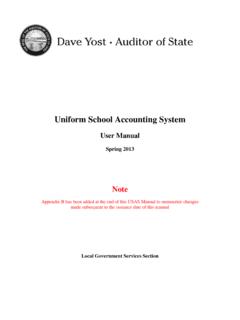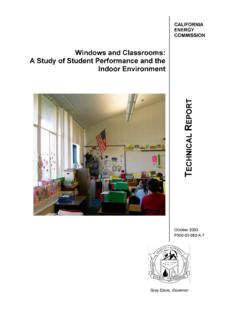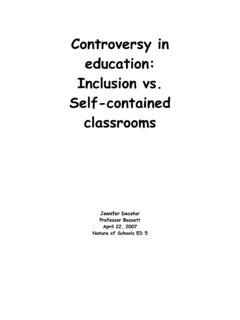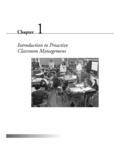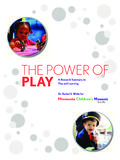Transcription of Crowdfunding Classrooms
1 SPECIAL REPORT | JULY 11, 2018 Crowdfunding ClassroomsWith sound policies in place, school districts can ensure that online fundraising enhances student learning88 E. Broad , OH photo illustration:stock images from office has received a number of requests from school districts for guidance on using Crowdfunding -- online fundraising that helps teachers and schools solicit donations of money and supplies to enhance class-rooms and enrich the education of their requests prompted my office to look into the issue and conduct a survey to see how Ohio schools are using s dedicated teachers already reach into their own pockets to buy extras for their students, personally donating an average of $600 every year, by one estimate.
2 But online Crowdfunding gives them an opportu-nity to reach out to contributors throughout their community and the world, generating donations that range from pencils and paper to music and sports equipment to unique classroom furniture designed to help special-needs students concentrate on with these benefits, Crowdfunding can pose some risks, including issues of student privacy, legal liability and harm to school reputation. This report is intended to make districts aware of them and suggest ways to avoid them. We don t want teachers or administrators landing in hot water inadvertently when they re simply trying to improve their Classrooms and the education they primary message is that school districts should have a Crowdfunding policy to ensure that these online cam-paigns are conducted in a way that will best serve districts, teachers, students and a sound policy in place, teachers and students can make the most of the opportunities that Crowdfunding REPORTA message from the Auditor4 SCHOOLS AND CROWDFUNDINGI ntroductionAcross Ohio.
3 Hundreds of school teachers are turning to Crowdfunding raising money and educational materi-als through Inter-net-based donation sites to provide students with addi-tional educational resources and is a valuable re-source for edu-cators, but it also poses significant legal and reputa-tional risks for teachers and school districts. To minimize these dangers, school boards should have policies to gov-ern how school personnel use a recent survey conducted by Auditor of State Dave Yost found that scores of Ohio school districts do not have policies governing teachers use of Crowdfunding , and even those that have policies might have gaps that leave them vulnerable to problems.
4 Thousands of teachers and schools have found Crowdfunding to be a useful tool, but it is a tool that should be used carefully, Yost said. Many Ohio school districts have recognized this and have designed Crowdfunding policies to minimize risks. Those that hav-en t adopted policies should do so. The simplest policy is to ban the use of Crowdfunding , and many districts surveyed have done. But this means for-going the potential benefits. It also might be difficult for districts to police, given the number of Crowdfunding sites that would have to be monitored to ensure that district teachers aren t using other option is to adopt a policy that sets rules for the use of Crowdfunding to ensure that the fundraising efforts do not violate state and federal law, that the money and education materials are appropriate for the district, and that they are properly accounted for in the district s inven-tory and books.
5 The policy also should contain provisions to prevent diversion of fundraising proceeds for private use and to protect the interests of donors, who expect that their gifts will be used for the purposes they report outlines the issues that school boards, dis-trict administrators and their legal advisers should take into account if district staff use AND CROWDFUNDINGWhat is Crowdfunding ?Every school year, teachers across the country dig into their own pockets to buy educational sup-plies to enhance the teaching they do in their Classrooms . By one estimate, teachers spend an average of $600 a year of their own money to buy things that their school districts and parents don t or can t provide for students.
6 This ranges from basics such as notebooks and pencils to specialized furniture designed to help spe-cial-needs students focus on these personal sacrifices can do only so much. So thousands of teachers nationwide have turned to Crowdfunding to seek donations of money and educational materials. Crowdfunding is the practice of fund-ing a cause by seeking donations from the public over the Internet. It has become a popular way to raise money for community and humanitarian causes, personal medical expenses, disaster relief, business capital and of online Crowdfunding sites exist, a number of them specif-ically designed to help teachers raise money. One well-known site called DonorsChoose says that it has helped with 600,000 classroom projects that have raised $621 million from almost 3 million individual and corpo-rate donors.
7 Other familiar Crowdfunding sites include AdoptAClassroom, ClassWish, EdBacker, GoFundMe, Indiegogo, Kickstarter, PledgeCents, and recent search of the DonorsChoose website showed 943 fundraising projects for Classrooms across Ohio. On the same day, AdoptAClassroom showed more than 901 fundraisers for Ohio schools. It s anyone s guess how many more hundreds or thousands of Ohio classroom campaigns are being hosted by the many Crowdfunding websites that are sites vary in how they handle fundraising. Some raise cash and make it available to the teacher or school. Others raise money to buy specific educational products and send those products to the school. Each has its own rules about how money and products are delivered to teachers and schools.
8 Sites also differ in the amount of support and advice they offer to educators in setting up their Crowdfunding Crowdfunding sites pay their overhead in a variety of ways, in-cluding requests for operational donations, retaining a percentage of the money raised, keeping discounts they earn by buying school supplies in bulk, or with corporate sponsors covering the administrative , these Crowdfunding sites provide a page devoted to each teacher s fundraising project. The page will include a narrative pitch for the fundraiser detailing how the teacher will use the money or products donated. These pitches often include photos of the classroom , the teacher and the students the donations will benefit.
9 The page also typically in-cludes instructions or a link for benefactors to make a the page is launched, teachers and students publicize it in as many ways as possible, including social media, to draw attention to the campaign and generate is the practice of funding a cause by seeking donations from the public over the Internet. It has become a popular way to raise money for community and humanitarian causes, personal medical expenses, disaster relief, business capital and AND CROWDFUNDINGThe SurveyTo get an idea of how Ohio educators are using Crowdfunding , the Ohio Auditor s office emailed an anonymous 21-question survey to all Ohio school districts. The survey drew 123 responses, or about 20 percent of the state s 600-plus school districts.
10 Re-spondents did not necessarily answer every the 121 school districts that answered the question, 54 ( per-cent) said they allow teachers to use Crowdfunding . The other 67 districts percent -- said they do not allow teachers to use if teachers in their school district are taking advantage of crowd-funding, 122 districts responded. Of these, 45 said teachers are using crowd-funding, 46 said they are not, and 31 said they do not those reporting Crowdfunding activities by teachers, 37 districts said that their teachers had initiated one to five Crowdfunding campaigns in the past 12 months, nine districts reported five to 10 campaigns, and four districts reported 10-20 campaigns.


